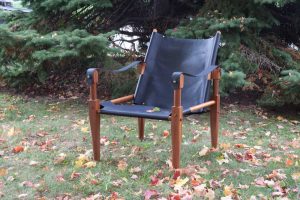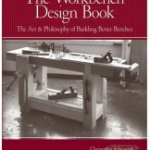We may receive a commission when you use our affiliate links. However, this does not impact our recommendations.
Roorkhee chairs are tough and lightweight – they have to be in order go to war or on safari.
To make your chairs as durable and lightweight as possible, here are some details to consider as you build your own. (What’s a Roorkhee chair? Read about them in the October 2012 issue of Popular Woodworking Magazine and watch me assemble one here.)
Keep the straps tight, but not too tight
The chair’s wooden frame is held together with leather or canvas straps, plus the seat and the back. When you assemble your chair, make sure that all of these cloth or leather components are snug. You want the seating material to pull the stretchers’ tenons into the legs and keep them seated.
If the straps are too loose, the conical tenons can slip slightly out of the mortises in the legs. Then, when someone sits down on the chair, their weight bears on the skinniest part of the tenon. The tenon can snap in some instances. We had this happen to one of my chairs at Woodworking in America in Pasadena, Calif.
But you can get things too tight, and that will also cause problems. While it would be difficult to make the seat strap or the legs strap too tight, it is possible to make the back too tight or make the arms too tight.
If you make the back or arms too tight, you’ll apply leveraging force to the tenons. If you then put your whole weight on a too-tight back or arms, you can cause that leveraging force to snap the tenon.
Use straight-grained wood
In chairmaking, it goes without saying that you should use legs and stretchers with dead-straight grain. That is why many chairmakers rive the material instead of sawing it. For a Roorkhee chair, you don’t really need dead-straight grain for the legs. They are thick and robust. For the 1” stretchers, however, it’s a different story.
Because these stretchers have to bear your entire weight, I think you need to use material that is as straight as possible. You don’t have to rive it, however. But when you buy the 1” dowels for the project, simply reject any that have any grain run-out. I’ve found that only about 10 percent of the dowels I encounter at the home center or hardwood store are straight enough for this chair. Dowels that have significant grain run-out can snap in some situations.
All-in-all however, if you break a dowel it’s not game over for the chair. All the components are replaceable and easily made. As I was experimenting with making these chairs, I made a few extra stretchers in case I ran into a problem. Adding a few extra dowels to the project doesn’t add much time at all.
— Christopher Schwarz
Here are some supplies and tools we find essential in our everyday work around the shop. We may receive a commission from sales referred by our links; however, we have carefully selected these products for their usefulness and quality.











Chris,
I’m just gearing up to make a pair of Roorkhee chairs based on the design in your Popwood article last year. Since the article was written, you seem to have made quite a few more, and I understand that you’ve made some improvements. Are those suggested improvements posted somewhere on the Popwood web site or elsewhere?
Regards,
Roy
Queensland, Australia.
I would be interested to know how the 12 1/2 inch seat height works out. All of the chairs in our house are 17-20 inches high at the seat. I should think a seat that low would be more like sitting on a small stool. Thanks.
I just costed out the materials and it looks like $600 for two chairs (white oak). I also noticed that the article stated you were working on a run of twenty for orders. What would be an approx sale price?
I just finished my chair this weekend following the article design. It looks just like yours which is what I was going for because I LOVE the details of your design.
The only change I made was to use copper rivets throughout and to ditch the leg straps in favor of an adjustable cross brace under the seat. If we can post links, then the link to pictures of my project will appear below:
http://s34.beta.photobucket.com/user/thenodnarb/media/Furniture/IMG_4591.jpg.html?sort=6&o=0
I still have to find the garnet shellac which apparently I have to order online. All I can find in stores is the orange/amber shellac.
Chris,
If I’m making this chair using canvas, what weight of canvas is recomended?
Thanks,
Bill
I am making this chair. The one in photo above doesn’t have the straps crossing the front legs and then again the back legs like the one in magazine. I like the style of the one above better. From what I gather you’ve substituted the two crossing straps with one strap with buckles that loops around the two side rails correct? What are the measurements for that strap? Thanks
I made a lot of these chairs commercially some years ago. I never used dowels from a hardware store, as they would not be the type of timber I wanted. So I made my own legs and stretchers, from straight grained timber of my choice. I used a woodlathe to turn them down, from 1 1/4″ (30mm) stock, which gave me a finished diameter just under 1 1/4″. I reckon 1″ diameter is a bit thin when large people plonk down in the chair. Beefed up is better and consistency of diameter is important aesthetically.
So you don’t have a wood lathe? Here are a few suggestions for making the stretchers round:
1. Use a router rounding over bit (with roller bearing) , with a radius of one half of the thickness of your square stock. Run it along each of the four corners, and you have created a round stretcher. A little sanding will help remove any irregularities. Irregularities are reduced if you use a router table, and keep a small square section at each end of the stick, which you have cut over-long to allow for this. This will help maintain the registration of the faces correctly.
2. Start with square stock and remove the corners to create an octagon. Do that again and you have a 16 faced polygon. Very nice just left like that! Or sand this profile to round. Sanding from 16 face polygon to the round is done by rotating it and bending sandpaper around the revolving stretcher. How about creatively chucking it in your drill press with a nail dead centre in the opposite end housed into a vice or piece of wood. It works, but you can’t beat a wood lathe for the sanding either…
How to create the polygon? Hand plane it, or use a table saw with a tilting arbor, etc. My favourite method is to create jigs for your thicknesser so you can consistently machine the faces. This way you can go further and create a 32 faced polygon if you are crazy enough!
3. In the spirit of our favourite anarchist, use your hand plane to take off the corners and then create the round. Use a spokeshave (or drawknife if you are experienced enough), use a moulding plane with a radius as close as you can get, create a scraper with the right kind of radius to help clean up the prifile consistently, etc.
…Just don’t use a dowel plate. It will look like crap, with torn fibres everywhere, slight dog-legs according to the grain deviations, etc.
Just remember, the true woodworking anarchist would not buy pre-made dowels on principle! Somebody else has determined the diameter and species of timber. No. Be your own independent person, choose your own wood type and diameter, create your own way of solving the problems, and go for it.
Just a word of warning about lovely straight grained hardwood stretchers – beware of “falling shakes” in the timber. Read and inspect your stock very carefully.
Above all, enjoy the delights of these beautiful chairs.
I’m planning on using a dowel plate to make my dowels. Hopefully being careful to choose straight grain will prevent problems. Good tip Chris.